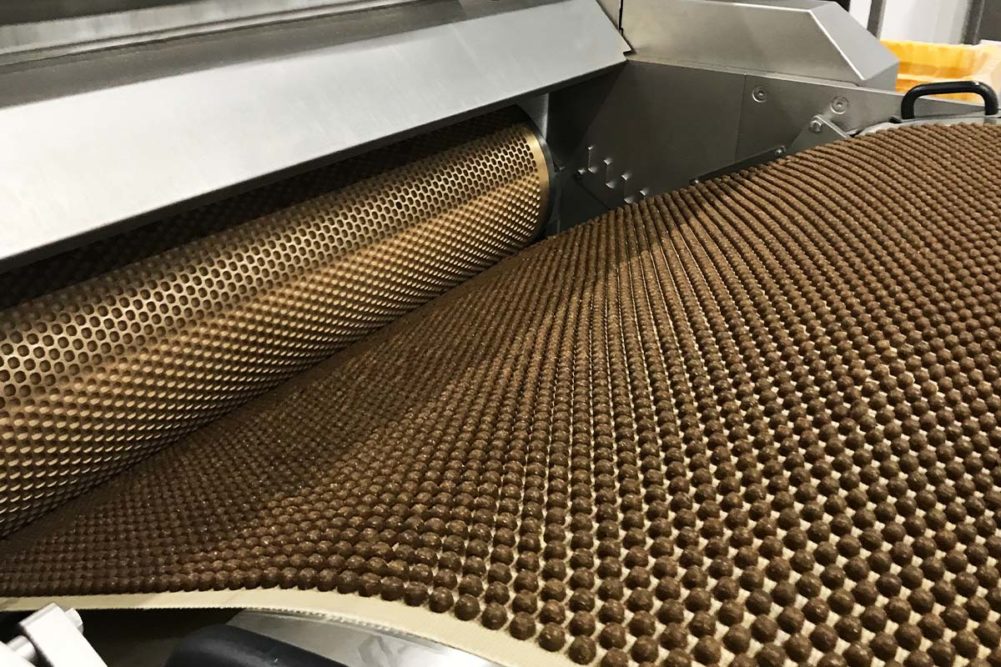This article was published in the September 2021 issue of Pet Food Processing. Read it and other articles from this issue in our September digital edition.
How can processors optimize baking time and maintain flexibility? Is it possible to use less energy to achieve the same result, while still meeting quality and food safety standards? And just how much control and insight can processors obtain over what is happening inside the baking chamber?
These are some of the questions pet food and treat manufacturers are asking of modern baking equipment. Katie Winkle, sales director, Baker Perkins Inc., Grand Rapids, Mich., highlighted three primary focus areas for Baker Perkins’ customers.
“They need flexible baking equipment that allows them to take advantage of unique new product opportunities in the baked pet treats sector, minimized production costs, and flexible recipe control to run a wide range of end products,” she said.
"In today’s landscape, companies cannot afford to be beholden to a single product environment,” said Katie Winkle, Baker Perkins.
Flexibility is key as brands expand their portfolios to include emerging formats and formulations.
“Many customers seek to future-proof with an oven that can bake every type of baked pet food and treat,” Winkle said. “Markets swing, and it may be necessary to produce a different product or products. In today’s landscape, companies cannot afford to be beholden to a single product environment.”
Flexibility and control
In today’s rapidly expanding market, perhaps the two most important aspects of a baking system are flexibility and control over the baking process. When combined, these two improvements can result in optimized efficiency, energy usage, baking time and data visibility.
Baker Perkins’ TruBake HiCirc oven is available for processors working with a broad range of products. It uses high-rate, direct convection heat with no heat exchanger, resulting in cost savings for fuel and maintenance, as well as a faster temperature response time compared to indirect convection ovens, Winkle said.
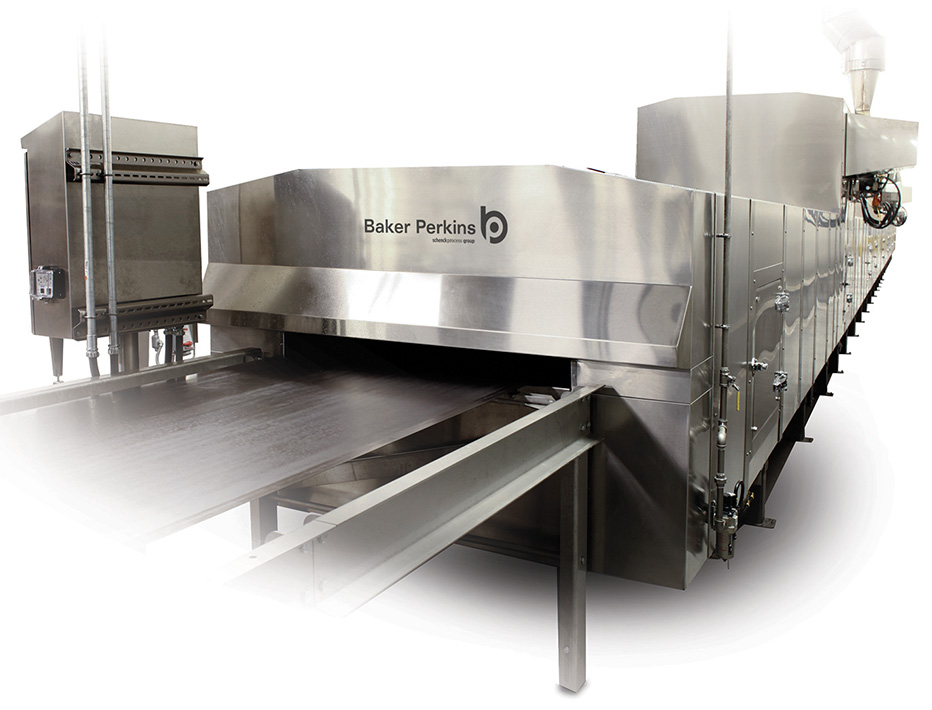 Baker Perkins has redesigned its TruBake ovens to incorporate a “TruClean” concept, effectively minimizing the need for maintenance, enhancing accessibility, and significantly reducing cleaning time. (Source: Baker Perkins Inc.)
Baker Perkins has redesigned its TruBake ovens to incorporate a “TruClean” concept, effectively minimizing the need for maintenance, enhancing accessibility, and significantly reducing cleaning time. (Source: Baker Perkins Inc.)“Recent innovations including redesigned ductwork and increased air flow bring higher rates of convection, and greater heat flux available for the baking and drying processes,” she said.
Baking can help processors achieve a more “minimally processed” product, a term becoming increasingly important to consumers. Baking at lower temperatures not only helps to preserve some sensitive ingredients but can also result in lower fuel usage.
“Baking can be achieved at a lower temperature by increasing the volume and velocity of the convection air,” Winkle said. “This is enhanced by a return system that quickly removes spent air from the baking surface and prevents slowing of heat transfer to the product. Faster baking and lower losses through the heating system lead to minimized fuel consumption.”
In many modern baking systems, recipes can be pre-programmed to reduce dependence on labor and ensure consistency day in and day out. Baker Perkins uses a touch-screen control panel to set up and run its TruBake ovens, including programming recipes, managing alarms and trending historical baking data.
TruBake ovens offer flexibility with modular builds to meet processors needs today and in the future. Depending on the recipe and baking profile of each product, operators can adjust temperature, extraction and airflow to fine-tune each cook.
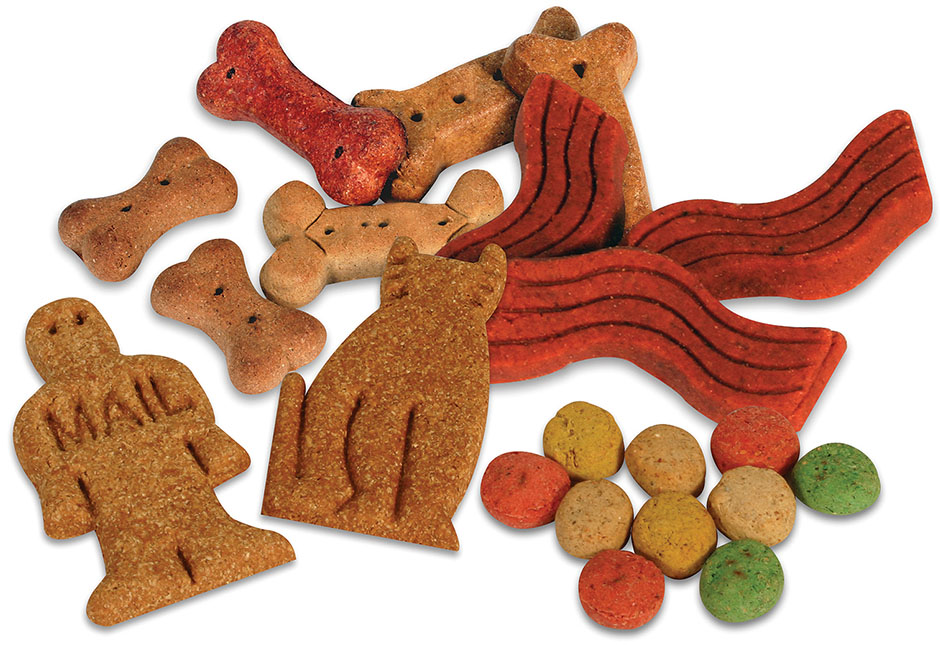 Today’s baking systems must be able to produce a variety of products efficiently, including different shapes, formats and formulas, while ensuring product safety, consistency and functionality. (Source: Baker Perkins Inc.)
Today’s baking systems must be able to produce a variety of products efficiently, including different shapes, formats and formulas, while ensuring product safety, consistency and functionality. (Source: Baker Perkins Inc.)
Reading Bakery Systems (RBS), Robesonia, Pa., has designed its ovens for flexibility as well. They are compatible with a variety of forming equipment, explained Sam Pallottini, director, cookie, cracker and pet food sales, RBS, and other components, such as a rotary moulder, low-pressure extrusion and/or wirecutting system, that can be easily swapped in and out.
“For example, a primary pet treat is produced with a rotary moulder,” Pallottini said. “If a customer then wants to produce co-extruded products, the rotary moulder can be moved out of position and replaced with either a low-pressure extruder or wirecut machine depending on the desired product. Our baking systems are designed to achieve the desired bake and moisture no matter what type of forming machine. We have even done extensive work feeding our ovens with low-pressure extruders to create a different type of product by combining two key systems in the pet food market.”
A unique quality among RBS ovens is the use of Thermatec tiles, used in the place of dampers, to create radiate heat. This method mimics traditional fire brick ovens to optimize heat transfer and contribute to color development, as well as reducing requirements for maintenance and gas.
The company has incorporated this technology into its new Emithermic tunnel oven, utilizing either direct or indirect baking to create a soft, radiate heat. Instead of having to heat the entire baking chamber — which often necessitates heating everything inside the chamber, including racks or belts, using up more energy and heat — the Emithermic oven and Thermatec tiles focus on a three-inch area above the baking band, thus eliminating the need for dampers. Pallottini noted RBS’ tunnel ovens are up to 30% more efficient than rack ovens and require a fraction of the labor needed to operate them.
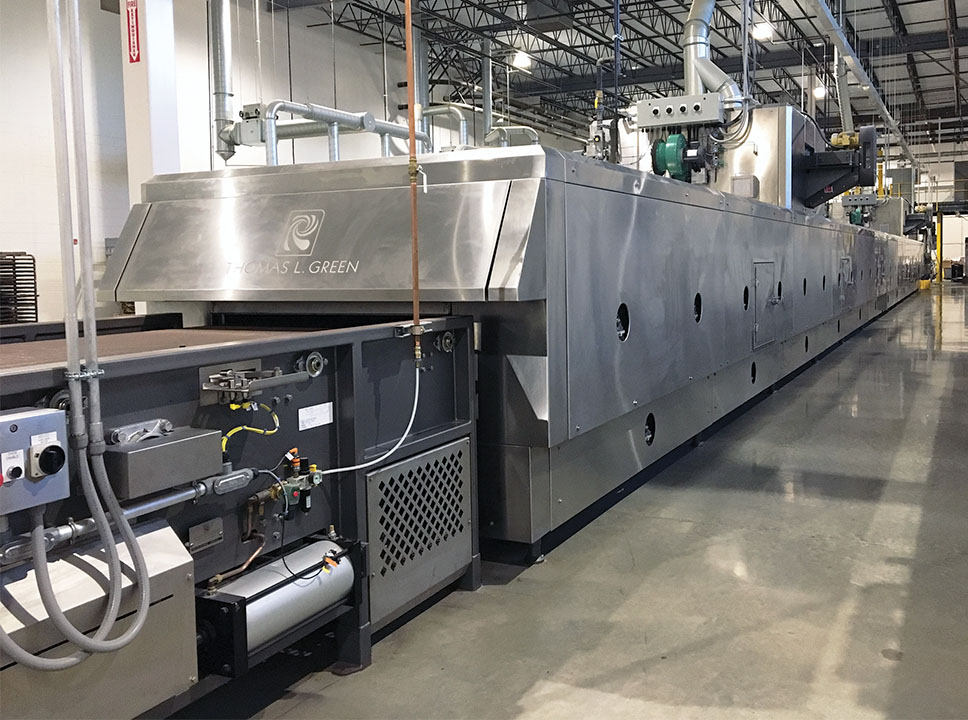 Speaking to the importance of flexibility, Reading Bakery Systems’ tunnel ovens are compatible with rotary moulders, low-pressure extruders and wirecut machines depending on what the product demands. (Source: Reading Bakery Systems)
Speaking to the importance of flexibility, Reading Bakery Systems’ tunnel ovens are compatible with rotary moulders, low-pressure extruders and wirecut machines depending on what the product demands. (Source: Reading Bakery Systems)
The Emithermic oven features individual top and bottom blowers inside the baking chamber, as well as an exhaust blower, all controlled through variable frequency drives (VFDs). Specifications for these blowers can be saved by recipe, and the entire process is designed to be more intuitive through the use of programming logistics control (PLC), which controls the bottom and top blowers, temperature and the exhaust.
“We find we’re easily 10% more [energy] efficient in the way we bake and our design, but you can find ways to improve that efficiency,” Pallottini said. “When you first start baking a product, most of the heat goes into the belt or the mesh to heat it up, then it can start baking the product. If you go to a thinner band or a lighter mesh or a more open-weave mesh, it takes less energy to heat that band up, then you can start baking your product faster.”
The company offers several ways to reduce energy usage, including the use of heat exchangers, lighter belts, better heat control, insulation and the use of hybrid ovens, which feature recirculation zones and convection zones to offer operators more control over the final product.
“We’re trying to enhance the perception that baked is better,” said Sam Pallottini, Reading Bakery Systems.
In addition to flexibility and efficiency, RBS’ Scorpion is a small, proprietary device equipped with a data logger that processors can literally bake alongside their product to measure four key variables: humidity, air flow, heat flux and temperature.
The Scorpion is run through the oven with product to measure consistency and ensure the process is meeting kill step specifications and target moisture levels for each formula. The data logger is then removed from the Scorpion and uploaded to software provided by the company to produce a “profile of the oven,” Pallottini explained.
‘A significant leap forward’
What if you could produce a safe, palatable and appealing pet food or treat product in a fraction of the time it typically takes to cook it? Steve King, vice president, global sales, Middleby’s ALKAR-RapidPak, Inc. business, Lodi, Wis., and others at Alkar took this question in stride to create the TurboChef.
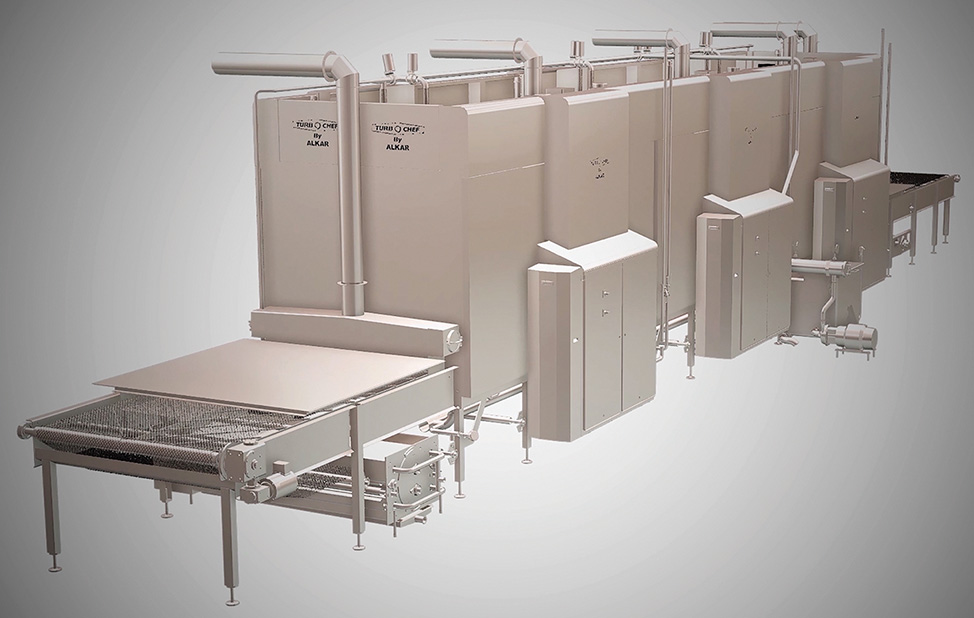 Alkar has built in what the company calls “handshakes,” signals sent between machines to communicate separation or other interruptions to the process. (Source: ALKAR-RapidPak, Inc.)
Alkar has built in what the company calls “handshakes,” signals sent between machines to communicate separation or other interruptions to the process. (Source: ALKAR-RapidPak, Inc.)
This oven system from Alkar uses a combination of microwave energy, steam and convection heat to cook from the inside-out (microwave), from the outside-in (convection), and provide a bio-kill step and final product color (steam). A microwave suppression tunnel absorbs any microwave leakage that might occur to ensure employee safety.
“To cook pet jerky is about a 10- to 12-hour process,” King said. “We’re cooking it in the TurboChef in about 15 minutes. For chew sticks that you would feed a dog that take about 6 hours, it takes TurboChef about 10 minutes. Then kibble in under 20 [minutes]… In pet food, we’re seeing a reduction of about 75% to 95% in cook times.”
Not only is the TurboChef able to drastically reduce baking time for these formats, it is also equipped for more efficient energy usage and a clean-as-you-go approach to sanitation.
“For example, in a standard convection or microwave line, the energy is being absorbed at a certain rate,” King said. “Our energy rate absorption is in the 80th to 90th percentile. We’ve figured out a way to get better absorption of energy into the cavity, and so we’re using less energy to get that cook result.”
The system is separated into 11-foot, independently controlled zones, with the three types of energy adjustable in each zone. Product is run through the system continuously on a 40- or 60-inch stainless-steel belt, which is more durable than plastic and easier to clean.
“In pet food, we’re seeing a reduction of about 75% to 95% in cook times,” said Steve King, Alkar-RapidPak, Inc.
The TurboChef is modular, and the number of necessary zones is determined for each individual customer or product. Alkar works directly with companies to test products, adjusting how much of each type of energy is needed in each zone to optimize the cook time without sacrificing key product attributes, like safety and color.
“When we designed this oven, we designed it with five specific things in mind,” King said. “Reduced footprint, improved efficiency, consistent performance, measurable performance, and improved throughput and productivity based upon the resources being used.”
Ease of access is also built into the TurboChef design. Alkar actively explored ways to minimize moving parts inside the oven – the only things that move are the belt, belt wash and a fan to drive the air in each zone. There are no ducts, and everything used to power the oven is located on the sides of the machine. Everything else inside the baking chamber, King said, “is powered through physics and science,” making it easier for operators to get inside the machine when needed.
“The people we worked with to design this didn’t make a living developing ovens – they’ve made a living developing medical research, weapons research, deep space research and controlling energy,” King said. “We went outside of the standard or the norms of the industry and went to the smartest people we could find when it came to applying energy, worked with them, and then we ran all sorts of simulations to see how to apply that energy and control it more effectively and efficiently.”
 The TurboChef by Alkar is able to cook high-meat pet treats, which typically take several hours, in a matter of minutes, with pet food cook times reduced by up to 95%. (Source: ALKAR-RapidPak, Inc.)
The TurboChef by Alkar is able to cook high-meat pet treats, which typically take several hours, in a matter of minutes, with pet food cook times reduced by up to 95%. (Source: ALKAR-RapidPak, Inc.)
Sanitation was also a priority, and Alkar figured out a way to meet sanitation standards in a way that is quick, effective, minimizes downtime and does not unnecessarily waste water. A belt wash system is located under the TurboChef, so as the belt is cycled through the oven, it then runs under the oven to be washed. There is a clean-in-place system inside every zone, which happens automatically and simultaneously after cooking. This speeds up changeovers and allows processors to run multiple SKUs on the same machine in the same day. Additionally, before water is used in the belt wash, it acts as a floor jacket to eliminate adverse cook-off effects during baking.
“By doing that consistently, as well as washing the belt, we can switch product SKUs in probably 30 to 45 minutes, depending on what they are,” King said. “The valuable thing for somebody who’s processing new products is, you can run four or five different SKUs on a TurboChef in a day.”
When describing what this technology means for the future of the industry, King likes to use a powerful analogy.
“In 1950, you could hop on a plane in Boston and fly to Los Angeles and it took you 14 hours and you stopped twice to get refueled,” King said. “That’s a great way to get across country. Now you can hop on a plane and fly across in five hours. It doesn’t mean that what they were doing before wasn’t good, we’ve just made a significant leap forward.”
Baking is a traditionally low-and-slow cooking method, but equipment manufacturers are turning up the heat to show companies that they can bake faster, smarter and more efficiently, and deliver products that speak to health-focused consumers and planetary pet parents alike.
Find more articles about the latest pet food processing technologies on our Equipment page.

